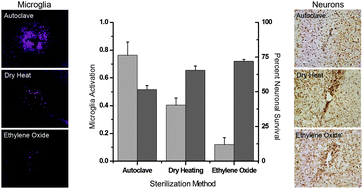The effect of residual endotoxin contamination on the neuroinflammatory response to sterilized intracortical microelectrodes
Abstract
A major limitation to the use of microelectrode technologies in both research and clinical applications is our inability to consistently record high quality neural signals. There is increasing evidence that recording instability is linked, in part, to neuroinflammation. A number of factors, including extravasated blood products and macrophage released soluble factors, are believed to mediate neuroinflammation and the resulting recording instability. However, the roles of other inflammatory stimuli, such as residual endotoxin contamination, are poorly understood. Therefore, to determine the effect of endotoxin contamination we examined the brain tissue response of C57/BL6 mice to non-functional microelectrodes with a range of endotoxin levels. Endotoxin contamination on the sterilized microelectrodes was measured using a limulus amebocyte lysate test following FDA guidelines. Microelectrodes sterilized by autoclave, dry heat, or ethylene oxide gas, resulted in variable levels of residual endotoxins of 0.55 EU per mL, 0.22 EU per mL, and 0.11 EU per mL, respectively. Histological evaluation at 2 weeks showed a direct correlation between microglia/macrophage activation and endotoxin levels. Interestingly, astrogliosis, neuronal loss, and blood–brain barrier dysfunction demonstrated a threshold-dependent response to bacterial endotoxins. However, at 16 weeks, no histological differences were detected, regardless of initial endotoxin levels. Therefore, our results demonstrate that endotoxin contamination, within the range examined, contributes to initial but not chronic microelectrode-associated neuroinflammation. Our results suggest that minimizing residual endotoxins may impact early recording quality. To this end, endotoxins should be considered as a potent stimulant to the neuroinflammatory response to implanted intracortical microelectrodes.

- This article is part of the themed collection: Emerging Investigators

 Please wait while we load your content...
Please wait while we load your content...